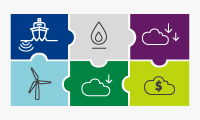Energy transition and climate change
In 2015, governments came together in Paris and achieved a landmark agreement to tackle climate change. We fully support the Paris Agreement’s goal to keep the rise in global average temperature this century to well below two degrees Celsius (2°C) above pre-industrial levels and to pursue efforts to limit the temperature increase even further to 1.5 °C. In pursuit of this goal, we also support the vision of a transition towards a net-zero emissions energy system.
The Intergovernmental Panel on Climate Change indicated through energy scenario based climate modelling in their 5th Assessment Report (2013, 2014) that limiting the rise in global average surface temperature to 2°C would require greenhouse gas emissions to reach net zero by around 2070. This needs to be achieved while recognising that the rising living standards of a growing population means that energy demand could double over the course of the century.
Today’s energy needs
The world gets most of its energy from coal, oil and gas, with around a fifth of all energy used to generate electricity. Energy sources differ across industry, transport and domestic use, which all need to transition to low-carbon options.
Reducing the net carbon footprint of the energy products we sell
In November 2017, we outlined Shell’s ambition to reduce the net carbon footprint of our energy products by around half by 2050 in step with society’s drive to align with the Paris climate agreement. This is an industry-leading position that will need periodic recalibration in line with the pace of change in the wider energy system.
For the Paris Agreement to be achieved, significant change in the energy system is required. Shell knows we can only remain a leading company if we evolve in line with societal expectations. Shell will adapt and play its part.
The world needs more energy and falling GHG emissions at the same time. This means that, on average, each unit of energy consumed has to come with a lower amount of GHG emission in its production, distribution and use, or in other words, a lower carbon footprint.
Greater disclosure on climate change risks and opportunities
We welcome and support efforts, such as those led by the Task Force on Climate-related Financial Disclosures (TCFD), to increase transparency and to promote investors’ understanding of companies’ strategies to respond to the risks and opportunities presented by climate change. We believe that companies should be clear about how they plan to be resilient in the energy transition. Therefore, we are working with the TCFD to develop guidance on effective disclosures which, where commercially possible, will be most relevant and useful to investors. The 2017 Annual Report and other publications aim to complement our Sustainability Report in responding to the TCFD recommendations, including discussing the energy transition and Shell´s portfolio resilience.
Find out more in the Shell Energy Transition Report at www.shell.com/energytransitionreport.
Nature-based solutions to compensate emissions
Nature has the potential to play an important role in the energy transition. In pursuit of a long-term low-carbon future, nature-based solutions present an immediate opportunity and can help to bridge the time that is required to scale the current generation of mature renewable energy technologies, or to develop the next generation of technologies. Also, they represent just one of several tools that Shell will focus on to meet our net-carbon footprint ambition.
We work with nature-based projects to prevent deforestation and restore natural ecosystems, creating carbon sinks. These projects, which also support local communities and conserve biodiversity, generate carbon credits that are then passed to energy consumers around the world. In the Netherlands, for example, we offer our business customers the opportunity to offset their CO2 emissions from driving their vehicles. One project we work with is the Kasigau Corridor in Kenya, developed by Wildlife Works, which protects 500,000 acres of highly threatened forest.
The projects we work with are certified by Verified Carbon Standard, currently the largest source of nature-based projects globally, and the Climate Community & Biodiversity Standard, which verifies that projects not only address climate change, but also support local communities and conserve biodiversity.
External voice: "We work with Shell on natural climate solutions"

Most climate efforts have rightly so far focused on reducing fossil fuel use. But we also know that nature plays a large role in storing and reducing carbon emissions that cannot be eliminated immediately. Natural climate solutions have the potential in the short term to deliver more than a third of greenhouse gas emissions reductions needed to prevent dangerous levels of global warming.
We are working with Shell to invest in nature offsets and deliver on the company's aspiration to reduce its net carbon footprint. Natural climate solutions are cost-effective, scalable and available nearly everywhere. We are unlikely to see a better carbon capture and storage opportunity than that which nature provides.
Over the next few decades, we plan to show leadership in the oil and gas industry, while responding in many different ways to society’s need for more and cleaner energy
 Sustainability at Shell
Sustainability at Shell
 Sustainable development goals
Sustainable development goals
 About our data
About our data
 Energy transition and climate change
Energy transition and climate change